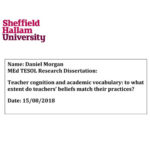The Companion to Language Assessment.
Edited by Antony John Kunan (2013). New York: John Wiley & Sons, Inc. pp. 1-2240
Reviewed by
Kioumars Razavipour
Shahid Chamran University of Ahvaz, Iran.
Language assessment has assumed new importance mainly because of the demands of the globalized world. It has a crucial role to play in education, language policy, immigration, economy, and identity formation and identification. The book addresses the concerns of a wide range of stakeholders including English language teachers, first language teachers, language test designers, language policy makers, language assessment scholars, and language testing students.
The companion comes in four volumes, with each volume containing four parts, with the exception of the fourth volume which has seven parts. While it is acknowledged that each volume deserves a separate review, care is exercised not to skip any of the main issues addressed in all volumes. The first volume, after an historical account of language assessment, details the assessment of various language abilities such as the four language skills, vocabulary, grammar, pragmatics, pronunciation, language contexts, literacy, and aptitude. It then moves on to assessing language ability in a diverse range of contexts including language testing in the military, in the court, in aviation, and in tertiary education. The first volume ends with a treatment of assessing the language of different groups of language learners such as that of young and heritage learners, teachers, teacher assistants, health professionals, and learners with communication disorders.
Four main themes constitute the second volume, namely, approaches to language assessment, assessment and learning, development of language tests, and the applications of technology in the measurement of language competencies. In the first part of this volume, large-scale language assessment, norm and criterion-related assessments, and task-based language assessments are explored. Issues related to alternative assessments like peer, self, dynamic, portfolio and performance assessments are discussed each in a separate, self-contained chapter. The third part of this volume touches on the actual process of developing language assessments. The stages in the whole testing cycle including defining constructs, writing items and tasks, developing scoring criteria, designing counter-cheating strategies, and the administration of language assessments are done justice to in the penultimate part of this volume. This volume ends with a treatment of the contribution of novel technologies to language testing; eye-tracking, corpora, new media, and the automatic scoring of writing are examined in different chapters.
Test validation, the question of ethics in language assessment, and matters of test consequence and washback are the major concerns of the first part of the third volume. Next, the major psychometric methods used in language testing are presented; classical testing theory, Item response theory, Rasch measurement; and factor analysis and structural equation modeling are among the methods discussed in the chapters in this part. The qualitative approaches of relevance to language assessment including content and discourse analysis, introspective methods, and issues involved in rating performance appear in the next part. The third volume closes with an examination of the prominent interdisciplinary concerns of language assessment. The realist, antirealist, and the instrumental philosophies of test validation; the interfaces of language assessments and SLA, and the use of assessments in program evaluation are among the main notions elaborated on in different chapters.
Finally, the fourth volume takes a geographical approach to various language assessments around the globe. Beginning with the major controversies surrounding the assessment of English, the volume then gives a separate part to the assessment of other languages in each of the continents of the world. The current practices in the assessment of a wide range of languages in North and South America, Africa, Asia, and Australia are examined in the final part of the volume.
This collection has numerous salient features not all of which can be cited here. First, it is second in comprehensiveness to no hitherto published material in the field. It takes much imagination and creativity to think of a topic related to language testing that has not featured in the companion. It will definitely remain a key contribution to language testing for the coming decades. Another distinctive characteristic of the book is the generous space it has given to the assessment of other languages. This gives it universal appeal because there are many people around the world in different countries who take an interest in the assessment of languages other than English. For such language testers, there was no source to turn to for a thorough review of the field. This lacuna is now filled with this publication. Moreover, the fact that chapters in the collection have been authored by people with diverse backgrounds from around the globe renders it representative of the collective thinking of the global community of language testers. Finally, the coverage given to the intersection of language assessment and philosophy, which was urgently needed in the field, is another strength of the publication.
As there is nothing perfect in the world, this publication despite its numerous admirable features has its own drawbacks. The criteria based on which chapters have been assigned to various parts seem, at times, to be fuzzy and ambiguous. For example, one wonders why issues related to teacher classroom assessments are discussed in the interdisciplinary discussions of language assessment. Finally, given the centrality of the notion of validity to all practices of language assessments, the theoretical underpinnings of validity theory appear to be underrepresented.
Despite the few minor shortcomings of the publication, it is a seminal work in the strict sense of the word. A copy of this companion is a must in the personal library of all those who have an interest in language assessment.
Kioumars Razavipour is an Assistant Professor of applied linguistics at Shahid Chamran University of Ahvaz, Iran. His main area of interest is language testing and assessment.








